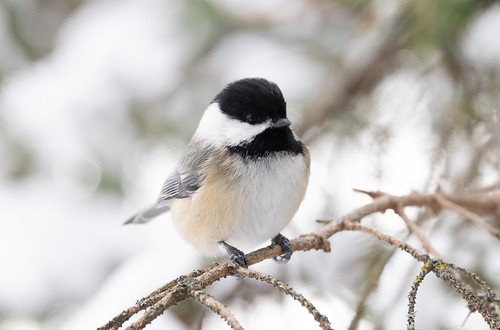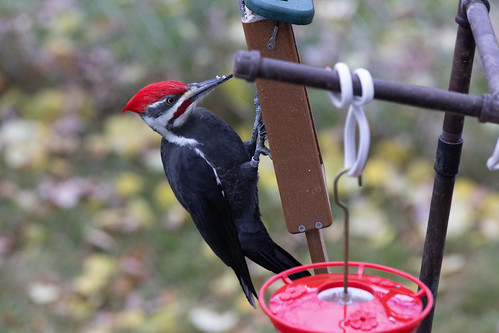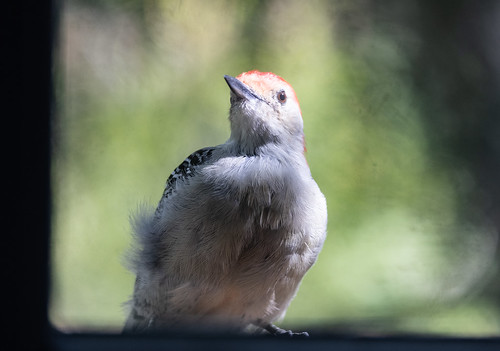Now that the Peabody Street Rufous Hummingbird of 2021 has moved on for the season and my backyard chickadees have been restored to their accustomed position as the tiniest, most beloved birds on the block, I’m back focused on the everyday escapades of my everyday birds on Peabody Street.
Three individual Pileated Woodpeckers have been visiting my suet feeder. The one female doesn’t come that often—I see her maybe once a week. But two different males have each been coming every day. They do act a little different—one is very laid back, staying put in the feeder when people or dogs are surprisingly close. He put on quite a show for birders when the Rufous Hummingbird was here. The other doesn’t seem skittish, but simply isn’t around when people are that close. Of course, some individuals are in a more or less tolerant mood on different days, so how can I be so certain that there are two different individuals? It’s easy when the right leg is visible. The easy-going, tolerant male is wearing a leg band while the other is unbanded.
For weeks, whenever I saw the banded male I took photos, each showing a small portion of the band with two or three digits of the nine-digit number. It took quite a few photos before I could finally work out the full number (115423658), which I sent to Frank Nicoletti, the research director at Hawk Ridge. When he has a chance to look it up, he’ll confirm whether he or one of his sub-permitees banded the bird, and if so, when and where, along with any interesting details they may have recorded.
I can see the Pileated at my feeders whether I’m downstairs looking out the kitchen or dining room windows, or upstairs standing at my home office window—the one window I can easily open, so that’s where I’ve been taking most of my photos of his leg band. When I’m working, I obviously can’t stand at the window too much, but my desk chair is exactly four feet from the window feeder, so even when I’m immersed in something, I notice the birds in that window feeder. My female Pileated and one of the males came to that window this fall when I was sitting at my desk, but I obviously couldn’t get up and walk over to open it for an unobstructed view, so the only photos and video I got of Pileateds in that feeder are through the glaring glass.
I got most of my pictures of the Rufous Hummingbird out that same window, but left it wide open between her feeding bouts. She didn’t seem to mind at all.
For a while, I was keeping my mealworm bucket on the floor under that window. When they came to the feeder, a couple of chickadees would fly right in, grab a couple of grubs, and fly right back out again.
Well into November, two Red-bellied Woodpeckers were visiting, but oddly enough, each day I saw only one—the male or the female. Whichever of the two I saw first thing in the morning was the one who appeared on and off all that day. For the past few weeks, it’s been only the female, and she’s appearing on and off every day.
The neighborhood flock of starlings has been spending more time in my yard than usual since the first snowstorm. Starlings are easily intimidated by people. They never come to the window feeder when the window is open, and if I notice one through the window glass, I wave my arm and it vamooses. The female Red-bellied Woodpecker quickly figured that out. When a starling flies in while she’s at the feeder and I wave my arm, she stays put.
It’s surprising how easily some birds adjust to us humans, and very pleasing when the ones who figure us out are the ones we want to keep near. My chickadees never seem to mind my clicking away, and the Rufous Hummingbird didn’t either, even when I moved about to get better angles. But the Red-bellied Woodpecker does mistrust me when the window is open, so I’ve yet to get good photos of her at the window feeder, but eventually I will. Waiting for lucky moments is the essence of birding, and what makes those lucky moments so sublime.







